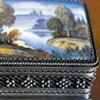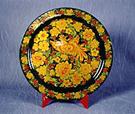Read the text and be ready to speak about Russian craft
Are articles of Russian craft still popular? What makes people buy them? In the remote ages the beauty meant much to the Slavic tribes. Moreover, being surrounded by thick forests they didn’t hurry to clear them for fields. Step by step they became engaged in different crafts: some people cut out spoons, others sharpened bowls and cups, the third part produced tools for spinning and weaving. Thus, the trees provided people with products which then were traded for food and other goods. Many folk decorative and applied crafts got their names from the villages where they were produced.
A. Palekh became famous for elegant black-lacquered art pieces on which the heroes of Russian folklore came to life. It was also one of the first ancient centres of icon drawing trade. They worked out a style which can be distinguished by the fine line tempera drawing saturated with gold. Their work was valued for the depth of its images and for their fairy-tale-like ornamental design.
B. The art of enameling is known to exist in Kyivan Rus back to the 11th century. Finift (from Greek “shining stone”) enamel is one of the oldest forms of decorating metal. Miniature enamels never lose color and shine stunningly. The superb artistry passes from generation to generation the main theme of this craft – a tribute to the beauty of Russian native land and to man’s eternal spirit.
D. Gorodets painters worked with small size ware or utensils (salt-cellars, boxes). As a rule, they used vegetation patterns of white colour. Often they decorated the interior of rooms and made an impression of idleness and smartness.
F. In the Bogorodskoye village craftsmen cut toys from linden. The most popular image is a bear, portrayed to be a quiet, kind and ridiculous animal holding either a basket of mushrooms and raspberries, or an accordion. According to a tradition some parts of a toy are made movable. And all toys look like caught in a movement.
G. The samovars became the symbol of Russian hospitality and family comfort as well as the sign of prosperity. But first samovars appeared only with the introduction of tea and coffee in Rus. Gradually, a peculiar ritual of tea-drinking emerged and was adopted in every Russian home.
1. What art has a deep symbolic meaning? 2. What items are not statistic? 3. What items showed the income of the family? 4. What items added much to interior of the house? 5. What art contributed much to preserving of the Russian character? 6. What items were not made of wood? 7. What items depicted the folklore images? 8. What items had reserved ornament rules? 9. What items had golden floral patterns? 10. What decorative applied art is the most ancient?
|




 C. Khokhloma became known for its unique, hand crafted wooden items. By using tin, extreme heat and lacquer, craftsmen were able to create the appearance of a gilded finish.
C. Khokhloma became known for its unique, hand crafted wooden items. By using tin, extreme heat and lacquer, craftsmen were able to create the appearance of a gilded finish. E. Mezen painting is the most ancient among the Russian artistic handicraft industries. Themes of the Mezen painting, laconic and expressive stylized drawings, have common features with the ancient rock drawings of the Russian North. They were of great importance in design of izbas fronts and interiors. The design follows the strict rules of ornament construction and every symbol has the meaning. The restrained colour, where the black outline emphasizes the strained sounding of the brownish-red colour, resembles unwittingly paleolithic cave painting of France.
E. Mezen painting is the most ancient among the Russian artistic handicraft industries. Themes of the Mezen painting, laconic and expressive stylized drawings, have common features with the ancient rock drawings of the Russian North. They were of great importance in design of izbas fronts and interiors. The design follows the strict rules of ornament construction and every symbol has the meaning. The restrained colour, where the black outline emphasizes the strained sounding of the brownish-red colour, resembles unwittingly paleolithic cave painting of France.




